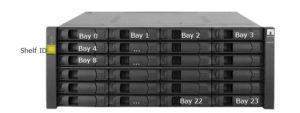In my last two posts I have briefly described Data ONTAP storage architecture (you can find those here: part 1, part 2). In this fairly short entry I want to show you how to identify Your disks within Data ONTAP. Why do you want to do so? Well, for example – a disk numbering enables you to quickly locate a disk that is associated with a displayed error message.
Data ONTAP 8.2.x and previous
Unfortunately it depends on your Data ONTAP version. With Data ONTAP 8.2.x (and earlier) drive names have different formats, depending on the connection type (FC-AL / SAS). Each drive has a universal unique identifier (UUID) that is a unique number from all other drives in your cluster.
Each disk is named wit their node name at the beginning. For example node1:0b.1.20 (node1 – nodename, 0 – slot, b – port, 1 – shelfID, 20 – bay).
In other words for SAS drives the name convention is <node>:<slot><port>.<shelfID>.<bay>
For SAS in multi-disk shelf the name convention is: <node>:<slot><port>.<shelfID>.<bay>L<position> – <position> is either 1, or 2 – in this shelf type two disks are inside a single bay.
For FC-AL name convention is: <node>:<slot><port>.<loopID>
Node name for unowned disks
As you probably noticed, this naming convention is kind of tricky. In normal HA pair each disks shelf is connected to both nodes. How come can you know which disk is named after which nodename? It’s quite simply actually: if disk is assigned (owned) by this node, it will take its name. If disks is unowned (either broken or unassigned) it will display the alphabetically lowest node name in this HA pair (for example if you have two nodes: cluster1-01, cluster1-02 all your unowned disks will be displayed as cluster1-01:<slot>…
Data ONTAP 8.3.x
Starting from ONTAP 8.3 drive names are independent of what nodes the drive is physically connected to and from which node you can access the drive (Just as a reminder, in healthy cluster drive is physically connected to two nodes – HA pair, but it’s accessed only by one node – owned by one node).
The drive name name convention is: <stack_id>.<shelf_id>.<bay>.<position>. Let me briefly explain those:
- stack_id – this value is assgined by Data ONTAP, is unique across the cluster and start with 1.
- shelf_id – shelf ID is set on the storage shelf when the slehf is added to the stack or loop. Unfortunatelly there is a possibility of shelf ID conflict (two shelves with same shelf_id). In such case shelf_id is replaced with unique shelf serial number.
- bay – the position of the disk within the shelf.
- position – used only in multi-disk carrier shelf, when 2 disks can be installed in single bay. This value can be either 1, or 2
Pre-cluster drive name format
Before the node is joined to the cluster it’s disk drive name format is same as it was in Data ONTAP 8.2.x
Shelf id and bay number
You may wonder how to read shelf id and bay number. It depends on the shelf model, however please take a look at this picture:
It’s shelf DS4243, that can contain 24 SAS disks (bay numbers from 0 to 23). Shelf ID is a digital number that can be adjusted during shelf installation.
